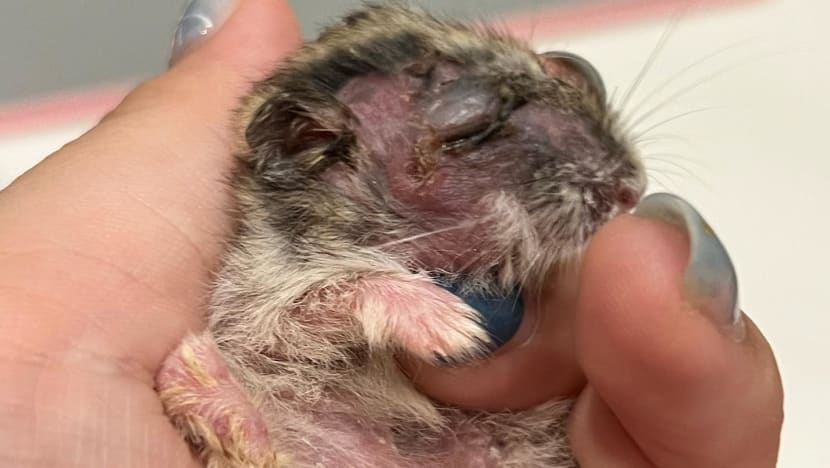Commentary: Are preschoolers equipped to care for classroom pets?
As a pet lover and mother to a preschooler, April Zara Chua is all about teaching children the importance of caring for living things. Classroom pets don’t quite promote the right lessons, she says.

According to Hamster Society Singapore, classroom pet Pamkin was found with multiple injuries including an eye abscess and a facial infection. (Photo: Facebook/Hamster Society Singapore)
SINGAPORE: When I heard the news that the authorities were investigating the alleged neglect of an injured classroom pet in February, my first thought was how no one in the preschool centre had noticed the hamster’s condition. It had only been noticed by a relative after a child took the hamster home, according to the Hamster Society (Singapore).
What was even more surprising to me was the fact that such cases may not be that uncommon. The volunteer group has said it also rescued two classroom pets from other preschools.
According to the Early Childhood Development Agency, there were 1,980 childcare and kindergarten centres in Singapore in 2022.
While having a classroom pet is not part of the curriculum, understandably, it can be an exciting learning journey. Most kids would be delighted and eager to learn all about their class pet, especially those who do not have pets at home.
For educators, the topic of animal care provides an opportunity for a more holistic approach as it can help nurture positive character traits such as responsibility and compassion.
GENUINE CARE OR MORE HOMEWORK
A friend of mine who is a preschool teacher in the private sector said she has introduced a terrapin to her playgroup class with successful learning outcomes. She noticed that the children, aged 18 months to 2 years old, became more responsible and compassionate, not only towards their class pet but to each other as well because they had to learn how to take turns when caring for their terrapin.
The kids were tasked with chores like cleaning the enclosure, changing its water, feeding it, and bringing it home on alternate weekends.
I’ve been a pet parent for about 20 years, so I know pets need care and attention to ensure nothing is amiss.
With classroom pets, one does wonder - are preschoolers mature or capable enough to notice if a pet is exhibiting abnormal behaviour?
When it’s their turn to take the class pet home, how do these short weekend stints look like to the kids? Are they genuinely happy and willing to be pet parents for the weekend or are they just treating it as homework?
I worry that sending a class pet home with a student gives the wrong message that all households are suitable for pets. Among other things, there are allergies, finances, and living conditions to consider too.
If my three-year-old were to bring home a pet for the weekend, I would want to set a good example on how pets should be handled.
But this assumes that all parents are comfortable handling animals. In reality, not all parents are equipped with pet care knowledge or are comfortable to act as weekend caregivers to their child’s class pet.
THE TYPE OF PET MATTERS
My friend said she only went ahead with the lesson plan after confirming that a pet lover colleague would take the terrapin in after the term ended.
She also picked a terrapin as they are known to require less maintenance. In fact, small reptiles and insects seem to be a popular choice for class pets because of their nature - minimal upkeep and solitary enough to be left alone over periods of time.
While the spotlight is on the preschool that allegedly neglected the hamster, I am certain there are centres that provide good homes for pets. There are even preschools that only take in rescues in hopes of providing them a forever home.
They have shown that with the right amount of supervision and guidance from educators, the kids can learn to be more mindful and these pets can thrive in classrooms.
THE RIGHT LESSONS
Ultimately, when it comes to the child, the onus is on both the educators and parents to instil the right lessons.
My son grew up with our seven-year-old cat and has shown that he understands what it means to respect animals. But getting to this point required dedication on our part as parents, to supplement what they learn in school.
Credit goes to our cat too for being so patient with a toddler who sometimes gets a little carried away when hugging (more like squeezing) or petting her. Once, after my son learned about facial features in school, our cat was subjected to some accidental poking as he tried to point out her eyes, ears, nose, and mouth to us (“Where are her eyebrows?”).
I’ve had three late pets and believe me when I say my former charges wouldn’t have made it easy for us - and that’s exactly what I mean, not all animals are suitable for a life living in such close proximity to curious kids.
So, if class pets are brought in to either complement lessons or provide a forever home to rescue pets, the animal’s well-being should be given higher priority and importance.
Perhaps make pet care workshops compulsory for schools with class pets, with limits to the number of pets a centre can have, along with occasional checks to ensure the pet’s basic needs are met and it is not living under stress.
As responsible adults, we should treat all living things with care and respect. Children, after all, look to us to show them the way.
It is only right we lead by example.
April Zara Chua is a freelance content developer and mother to a preschooler and a 7-year-old cat. She was also formerly from the pet industry covering topics on responsible ownership, care, health and welfare.




















